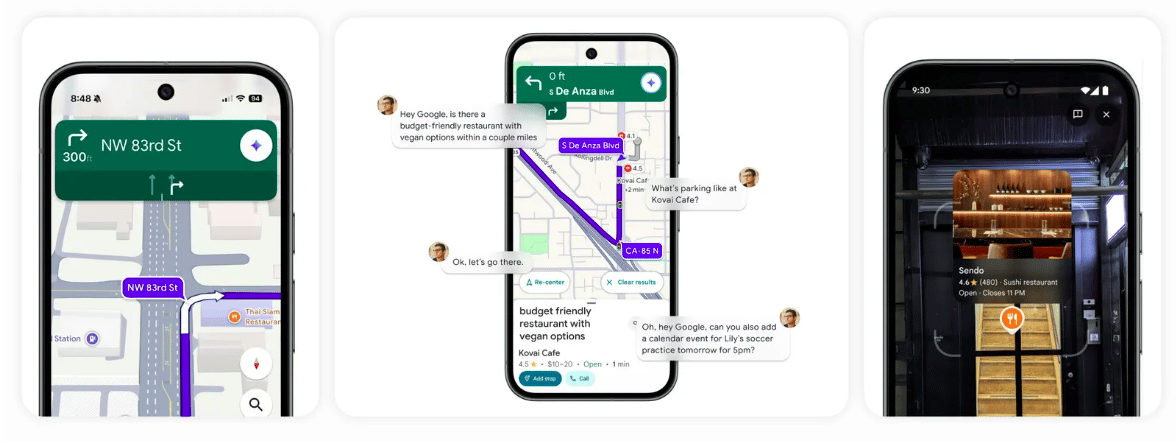Welcome to Jumble, your go-to source for AI news updates. This week, Tinder is taking a bold leap into algorithmic romance with a new feature that learns your personality from your photos, while Google Maps is turning talkative thanks to Gemini. Let’s dive in ⬇️
In today’s newsletter:
💕 Tinder’s AI wants to understand your vibe through your photos
📍 Google Maps gets chatty with Gemini
🧬 Scientists blend AI and biology to study human disease
🛠️ Tesla eyes a mega AI-chip fab with Intel in its sights
🎯 Weekly Challenge: See how human your map feels
📱 Tinder Uses AI to Make Smarter Matches
Dating just got a data upgrade. Tinder is quietly rolling out a new AI-powered matching experience that studies your answers, photos, and behavior to build what it calls a chemistry feature. The feature, live in early test markets, promises matches that feel closer to your real-world interests instead of random swipes.
Here’s how it works. After tapping the diamond icon in the Discovery screen, users answer short interactive questions about themselves. Those answers, along with your public profile, shape a “Daily Drop” — a small batch of curated matches meant to minimize endless scrolling.
If you choose to opt in (when it’s widely available), Tinder’s algorithm can also analyze your camera-roll photos for context clues (i.e., hiking trails, pets, or concerts) to infer lifestyle patterns. The AI then learns which details seem important to you and uses them to refine who appears in your queue. The lines between AI and dating have been blurred for a while, though, there’s very been very little feedback since they began rolling out.
💡 Why It Matters
Tinder’s parent company Match Group says the feature is central to its 2026 strategy after nine consecutive quarters of subscriber decline. The goal: less fatigue, more intent. Instead of quantity, Tinder wants to sell the promise of “smarter swiping” — a sense that the algorithm actually gets you.
⚖️ The Trade-Offs
Privacy: Granting photo access means the AI can scan personal images, raising concerns about unintended data exposure even if the feature is optional.
Control: Tinder added an Insights Hub for reviewing and deleting AI assumptions so you can see what the system “knows.”
Effectiveness: The rollout in Australia and New Zealand is still experimental, so results vary widely.
🧭 How to Try It
This feature should be available in many markets in early 2026, when available, opt in only if you’re comfortable sharing lifestyle photos, then explore your curated matches for a week. Use the Insights Hub to track what the algorithm highlights — and whether it actually nails your vibe. If not, opt out. The diamond will stay, but the choice is yours.
CTV ads made easy: Black Friday edition
As with any digital ad campaign, the important thing is to reach streaming audiences who will convert. Roku’s self-service Ads Manager stands ready with powerful segmentation and targeting — plus creative upscaling tools that transform existing assets into CTV-ready video ads. Bonus: we’re gifting you $5K in ad credits when you spend your first $5K on Roku Ads Manager. Just sign up and use code GET5K. Terms apply.
🗺️ Google Maps Gets Conversational With Gemini AI
Navigation is turning human. Google Maps is integrating Gemini, Google’s conversational assistant, so drivers can ask questions, adjust plans, and get real-world context without leaving the map.
Instead of robotic commands, Gemini lets you speak naturally: “Find a vegan lunch within three miles, check parking, and add the ETA to my calendar.” The AI handles it all in one thread — no screen tapping required.

Credit: Google
⚙️ What’s New
Landmark-based navigation replaces distance cues: you’ll now hear “turn after the Thai Siam Restaurant” instead of “in 500 feet.”
Multi-step voice tasks now work mid-drive, like finding EV chargers or sending your ETA hands-free.
Proactive traffic alerts and instant reports flag flooding or closures as you approach.
🚀 Why It Matters
Gemini turns Maps into an assistant that anticipates needs, not just directions. For busy commuters, it could mean fewer distractions and smarter rerouting, a genuine step toward a safer, conversational cockpit. Google says the system cross-references Street View images and 250 million places to ensure every landmark cue matches what you’ll actually see.
⚠️ Before You Try It
The rollout starts in the U.S. and expands to Android Auto soon. Gemini’s accuracy depends on up-to-date local data, so expect early hiccups if you live outside major cities. Privacy-minded users can limit access to calendar and photo data, but full functionality relies on sharing context.
This Week’s Scoop 🍦
🎯 Weekly Challenge: Test the AI Features in Google Maps
Challenge: Try out the new AI-powered navigation in Google Maps and see how seamless Gemini feels on the road.
Here’s what to do:
🗺️ Open Maps while you’re parked or riding shotgun (safety first).
💬 Ask a multi-step question like: “Find a vegan lunch spot within three miles, check parking, and add the ETA to my calendar.”
👀 Watch how Gemini responds — does it handle everything in one smooth flow or bounce between screens?
⚡ Note what worked best: was it the context awareness, the speed, or how naturally it kept the conversation going?
🌀 Optional twist: try the same query during a real drive and notice how Gemini uses landmarks instead of distance — “Turn right after the Citgo gas station” hits differently than “turn in 500 feet.”
The more you explore, the smarter your map gets.
Want to sponsor Jumble?
Click below ⬇️
Which feature are you more likely to try, Tinder’s camera-roll AI or the Gemini assistant in Google Maps? Let us know your pick and why. See you next time! 🚀
Stay informed, stay curious, and stay ahead with Jumble!
Zoe from Jumble




